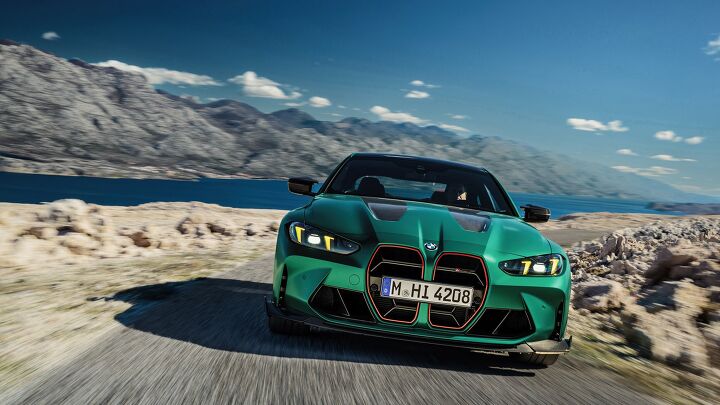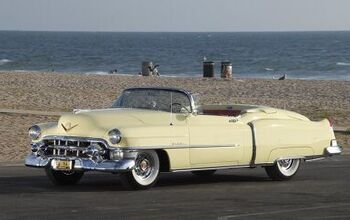The 2025 BMW M4 CS is a Lightweight Carbon-Packed Track Monster

BMW has gotten plenty of mileage from its inline-six engines, but it’s not done yet. The 2025 M4 CS will debut on May 10, sporting a 543-horsepower turbocharged engine, plenty of carbon fiber-reinforced plastics, and chassis reinforcements to give it razor-sharp handling.
The $124,675 coupe uses BMW’s S58 inline-six-cylinder engine, which also powers the M4 GT3 race car that won the DTM title in 2022. It uses a 3D-printed cylinder head core that improves cooling, and the oil system has been revised to maintain lubrication during high revs and aggressive cornering. The engine has 20 more horsepower than the M4 Competition Coupe, which BMW said is due to it cranking the turbos up to 30.5 psi. It also makes 479 pound-feet of torque and sports a 7,200 rpm redline. That power hits all four wheels through an eight-speed automatic transmission, an active M differential, and BMW’s xDrive AWD system.
An M4 CS-specific adaptive M suspension system provides adjustable damping settings, and forged alloy wheels reduce unsprung weight. Track tires or ultra-track tires are available as no-cost options.
BMW employed carbon fiber-reinforced plastic and full carbon fiber to cut the car’s weight. It features a carbon roof, while the hood, front air intakes, mirror caps, rear diffuser, and rear spoiler are made from the carbon-plastic composite. Even the exhaust is lighter, cutting eight pounds from the car with a titanium muffler, and BMW said the M4 CS is 77 pounds lighter overall than the M4 Comp.
Interior features include an Alcantara-wrapped steering wheel and the automaker’s annoyingly ass-crunching M Carbon Bucket Seats. The fact that they’re upholstered in Merino leather is nice, but most of us are too wide to fit into them without significant discomfort. BMW’s iDrive 8.5 infotainment software runs on a 12.3-inch digital gauge cluster and 14.9-inch touchscreen, and the car gets unique widgets to monitor and manage its performance.
[Images: BMW]
Become a TTAC insider. Get the latest news, features, TTAC takes, and everything else that gets to the truth about cars first by subscribing to our newsletter.

Chris grew up in, under, and around cars, but took the long way around to becoming an automotive writer. After a career in technology consulting and a trip through business school, Chris began writing about the automotive industry as a way to reconnect with his passion and get behind the wheel of a new car every week. He focuses on taking complex industry stories and making them digestible by any reader. Just don’t expect him to stay away from high-mileage Porsches.
More by Chris Teague
Latest Car Reviews
Read moreLatest Product Reviews
Read moreRecent Comments
- Redapple2 All this BEV investment. A bigger impact (less oil consumption) would have been made if we had made PIG UP trucks smaller since 2000 and not HUGEr. (And raised gas tax by $2-3/gallon.)
- ChristianWimmer One of my clients is a company that is actually producing eFuels in Leipzig. Yes, they require a lot of energy to produce but this would not be an issue if Germany had nuclear energy or used the excess energy from wind and solar to produce these fuels. In such a scenario the energy losses wouldn’t really matter.Also, I am told that nations like Spain or the North African nations like Morocco or Tunisia could be ideal places to produce eFuels/Hydrogen due to their abundance of solar power. Again, the energy loses here would not matter since the energy used to produce these fuels is essentially “free”. If this path were pursued, Morocco and Tunisia could become wealthy nations and exporters of eFuels and Hydrogen. Countries with an abundance of solar or wind or hydro energy could be producing eFuels for their domestic consumption and export.Another argument which to me is irrelevant these days ist the poor thermal efficiency of ICE engines (25-35% gasoline, 40-45% diesel). One long trips with cruise control set to 130 km/h and even the occasional venture into the 180-200 km/h zone, my fully loaded (with my gear) A250 (2.0 4-cylinder 224-hp Turbo) can achieve an impressive gas mileage of 6 L / 100 km. That’s phenomenal - I am looking at six 1 liter bottles of water right now and that’s all my car needs to travel 100 km… amazing.So, I am a supporter of eFuels. I love internal combustion engines and if we want to use them in a climate neural way, then eFuels are a must. Also, to me every ICE car is way more sustainable and longer-lasting an an EV. Mazda, Toyota etc. are making the right move IMO.
- Blueice Once you infuse governmental unit regulation & [marketing] and taxpayerfunding, one knows quite well, dat the product or service isdestine to fail; which includes battery vehicles. Just axe yourself how revolutionary have your home batterydevices become ??? I am still waiting. after three decades, for a battery shaver whichonly requires charging two or three times per year.I am glad that I do not have a plug in Frau.
- Tassos Such a heavy breadvan on stilts, with so much HP, AND with ONLY 100 KWH Battery, I doubt if you will ever see 250 miles, let alone 300, under the best of conditions. In the winter, count on 150 miles range.And NO, it looks TERRIBLE. The only SUV that looks great is the RANGE ROVER.
- Tassos They sure are doing the right thing in the SHORT and MEDIUM term.As for the long term, in the long run, YOU'LL ALL BE DEAD, so WHO CARES.





































Comments
Join the conversation
keep the color. lose the stupid front design. make it reliable, at least as reliable as a base 911. Then and only then is it somewhat worthy of that price.
I’m not an engineer but 30psi seems really high for factory turbo.